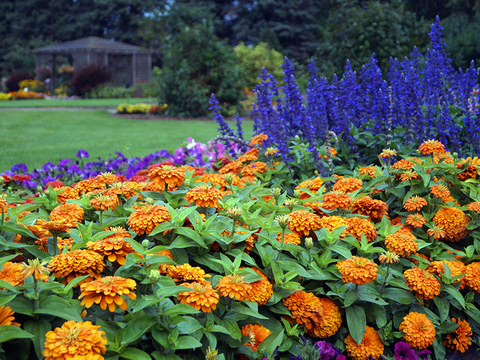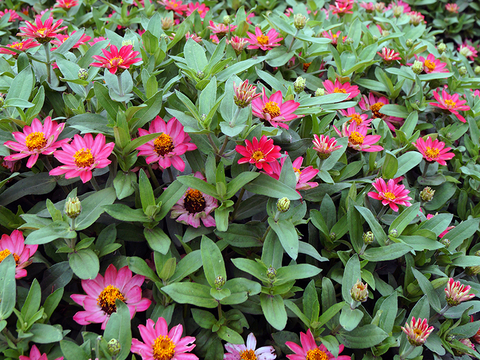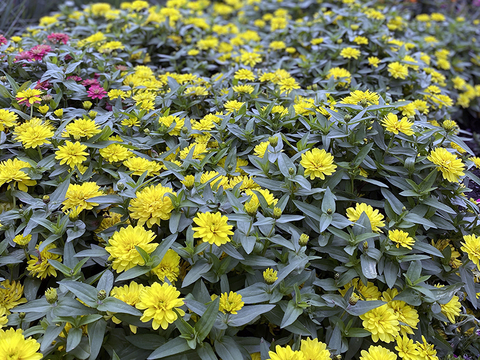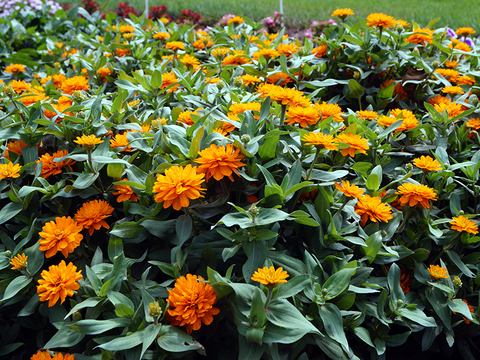Quick facts
- Zinnias are very prolific bloomers all season long and perform well in garden beds.
- Zinnias prefer full sun and well-drained soil.
- Zinnias are highly attractive to pollinators, particularly butterflies.
- Three types of blooms: single, double, and semi-double.
- Zinnias have a wide range of heights, growth habits and flower colors.
Zinnias are a popular plant for annual gardens due to how easy they are to grow and how quickly they can grow, both from seed and as transplants. The vast range of growing habits also leads to their popularity as they can be anywhere from short and bushy to tall with a singular stalk. And, no matter what the growing habit is, Zinnias are prolific bloomers. They are a member of the aster family and are native to Mexico and Central America and perform very well throughout Midwest summers.
The foliage of a Zinnia is varying shades of green, but the flowers can come in nearly all colors and sometimes a combination of colors.
There are three distinct types of Zinnia based on floral structure: single, double and semi-double. The different floral structures do not necessarily correlate with plant habit.
- Single means that the flower only has a single row of petals, and the center of the flower is clearly visible.
- Double zinnias have multiple rows of petals, and the center is not clearly visible.
- Semidouble cultivars have a combination of traits. The flowers have multiple rows of petals but have a clearly visible center.
Good performers
Annual zinnias are evaluated as part of the U of M flower trials and research. Located at the WCROC in Morris, Minn., the Horticulture Display Garden serves as an All-America Selections (AAS) Display Garden and Trail Grounds and provides the public an opportunity to view the newest superior performers.
The following annual zinnia cultivars were rated good to excellent in our recent trials:
- Double Zahara™ series
- Magellan™ series
- Preciosa™ series
- Holi series
Growing outdoors
Zinnias perform better in garden beds than containers and, due to their ability to grow so quickly, can be direct-seeded. To direct seed, make sure the soil temp is at least 70 degrees and plant the seeds at 1/4'” deep. Of course, planting transplants instead of direct seeding is an option as well and can be done once the soil warms to 60 degrees.
Plant spacing can be anywhere from 8 to 24 inches depending on the plant habit. Plants with a singular stalk can be planted closer together while bushier plants will need more space.
When choosing a site to plant zinnias, keep this in mind:
- Must have full sun for 8+ hours a day. They perform best in a very warm location.
- Soil must be well-drained. To improve drainage, compost or sand can be incorporated into heavy soils.
- Zinnias prefer soils with a pH of 5.5-7.5.
Feeding and watering
A general-purpose fertilizer with equal amounts of nitrogen, phosphorous, and potassium should be incorporated into the soil at the time of planting. After planting, zinnia should be fertilized monthly using a fertilizer with a higher phosphorous than nitrogen content to promote new blooms.
Zinnias require regular watering but do not overwater as they can tolerate dryer soil better than overly wet soil and too much water can cause fungal diseases. Only water when the top 1-2 inches of soil are dry and try to water the base of the plant and not the foliage when possible.
Zinnias are highly susceptible to powdery mildew. This can be treated by spraying with a fungicide, but it is best to try and prevent it by avoiding wet foliage and making sure the plants get plenty of air circulation.
Other tips for abundant blooms and healthy plants:
- Plants can be pinched to promote a bushier plant if flower stalks can’t support flower heads.
- Removing old blooms from the plant will promote the production of new flowers.
- Keep the soil surface clean to prevent the growth of disease.
Propagation
Zinnia seeds can be started indoors about 6 weeks prior to the anticipated outdoor planting date. Use a growing media specifically designed for germinating seeds. Follow these guidelines for successful seed propagation:
- Plant ¼” deep and cover with vermiculite.
- Keep the seed and media moist by using a plastic cover over the seeding tray.
- Zinnias need darkness to germinate so use a black plastic cover if possible.
- Seeds will germinate in 4-8 days at 70-75°F
- After germination, grow plants at 70-75°F during the day and 65-70°F at night.
- To avoid dampening off, let the media dry out slightly between waterings.
Zinnias can also be propagated via cuttings as well in about 3-4 weeks if desired.
- To do this, cut 4-6 inches off the top of the plant and then remove the leaves off the bottom half of the cutting.
- Place the cutting in enough water to cover where the leaves were removed.
- Once roots begin to grow, they can be transplanted into soil.
Good to know
Zinnias work great in cut flower displays due to their wide range of colors and amounts of petals per flower head. To keep fresh-cut flower displays looking their best, be sure to change the water every two days.
When using zinnias to attract pollinators, be sure to choose cultivars that contain pollen and nectar, as this trait has been bred out of some zinnia cultivars. This information can usually be found on the seed packet.
Reviewed in 2022







